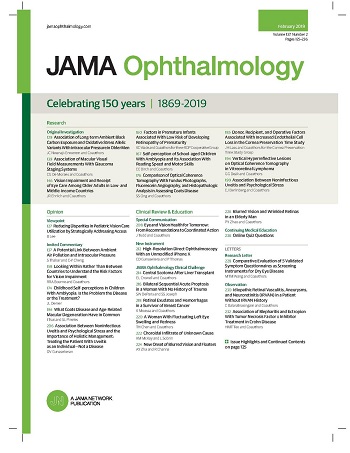哺乳动物靶雷帕霉素抑制作为预防增殖性玻璃体视网膜病变的治疗靶点。
IF 9.2
1区 医学
Q1 OPHTHALMOLOGY
引用次数: 0
摘要
重要性使用全身性哺乳动物雷帕霉素靶蛋白(mTOR)抑制剂(MTI)治疗可能对增殖性玻璃体视网膜病变(PVR)的发展有益。目的探讨全身性MTI治疗在初次视网膜脱离(RD)修复患者中预防PVR的应用。设计、环境和参与者:这是一项回顾性队列研究,汇总了来自15个国家2003年1月至2025年1月的未识别电子健康记录数据。该研究包括681例患者,这些患者在首次RD修复前至少3个月和1年后接受了全身MTI治疗。该队列与对照组47例 626例从未暴露于全身性mTOR抑制的患者进行比较。在倾向评分匹配后,每个队列中681例患者在首次RD手术后1年后的结果进行了分析。根据是否使用RxNorm编码对患者进行系统mTOR治疗进行分层。随访6个月和1年内发生pvr相关RD并需要后续眼部干预包括玻璃体切割(PPV)和复杂RD修复的相对风险(RR)。在接受全身MTI治疗的同时进行初始RD修复的患者分别与同时使用全身甲氨蝶呤(MTX)进行相同措施的匹配队列患者在6个月和1年进行比较。结果分别有681例和47例 626例患者在PSM之前分别接受了初始RD修复并同时使用MTI或不使用MTI。MTI队列的平均(SD)年龄为66.5(15.4)岁;女性319例(46.8%),男性319例(46.8%)。在对照组中,平均(SD)年龄为64.5(17.6)岁;女性16例 140例(33.9%),男性27例 858例(58.5%)。在1年时,同时使用全身MTI治疗与随后发生RD的风险降低相关(RR, 0.58;95% ci, 0.36-0.94;P = .03),与接受初始RD修复而未接受全身MTI治疗的匹配患者相比。此外,同时使用全身MTI治疗与随后需要PPV的风险降低相关(RR, 0.57;95% ci, 0.40-0.82;P < 0.001)和复杂RD修复(RR, 0.60;95% ci, 0.40-0.91;P = 0.01),与在1年内接受初始RD修复而未接受全身MTI治疗的匹配患者进行比较。在6个月和1年期间,将接受初始RD修复并同时接受全身MTI治疗的患者与同时接受全身MTX治疗的匹配队列患者进行比较,在随后RD的发展和PPV或复杂RD修复的需要方面没有差异。与未接受全身性MTI治疗的患者相比,接受初始RD修复并同时接受全身性MTI治疗的患者发生pvr相关RD的可能性较小。需要进一步的研究来调查MTI治疗在这种潜在的PVR预防中的安全性和有效性。本文章由计算机程序翻译,如有差异,请以英文原文为准。
Mammalian Target Rapamycin Inhibition as a Therapeutic Target for Prevention of Proliferative Vitreoretinopathy.
Importance
The use of systemic mammalian target of rapamycin (mTOR) inhibitor (MTI) therapy may confer benefits against the development of proliferative vitreoretinopathy (PVR).
Objective
To examine the use of systemic MTI therapy for the prevention of PVR among patients who underwent initial retinal detachment (RD) repair.
Design, Setting, and Participants
This was a retrospective cohort study aggregating deidentified electronic health record data from January 2003 to January 2025, from 15 countries. The study included 681 patients who underwent primary RD repair while receiving systemic MTI therapy at least 3 months before and 1 year after initial RD repair. This cohort was compared with a control group of 47 626 patients never exposed to systemic mTOR inhibition. After propensity score matching, outcomes from 681 patients in each cohort were analyzed after 1 year following their initial RD surgery.
Exposures
Patients were stratified by use of systemic mTOR therapy or not using RxNorm code.
Main Outcome and Measures
Relative risk (RR) of developing a PVR-related RD and requiring a subsequent ocular intervention including pars plana vitrectomy (PPV), and complex RD repair within 6 months and 1 year of follow-up. Patients who underwent initial RD repair while receiving systemic MTI therapy were separately compared with a matched cohort of patients with concomitant use of systemic methotrexate (MTX) for the same measures at 6 months and 1 year.
Results
A total of 681 and 47 626 patients who underwent initial RD repair with concomitant use of an MTI or not, respectively, were identified prior to PSM. The mean (SD) age in the MTI cohort was 66.5 (15.4) years; 319 (46.8%) were female and 319 (46.8%) were male. In the control cohort, the mean (SD) age was 64.5 (17.6) years; 16 140 (33.9%) were female and 27 858 (58.5%) were male. At 1 year, concomitant use of systemic MTI therapy was associated with a decreased risk of developing a subsequent RD (RR, 0.58; 95% CI, 0.36-0.94; P = .03) compared with matched patients who underwent initial RD repair without exposure to systemic MTI therapy. Moreover, concomitant use of systemic MTI therapy was associated with a decreased risk of requiring subsequent PPV (RR, 0.57; 95% CI, 0.40-0.82; P < .001) and complex RD repair (RR, 0.60; 95% CI, 0.40-0.91; P = .01) when compared with matched patients who underwent initial RD repair without exposure to systemic MTI therapy at 1 year. There was no difference in the development of subsequent RD and need for PPV or complex RD repair when comparing patients who underwent initial RD repair with concomitant systemic MTI therapy to a matched cohort of patients with concomitant use of systemic MTX therapy at 6 months and 1 year.
Conclusion and Relevance
Patients who underwent initial RD repair and were concomitantly being treated with systemic MTI therapy were less likely to develop a subsequent PVR-related RD compared with matched patients not exposed to systemic MTI therapy. Future studies are needed to investigate MTI therapy safety and efficacy profile in this setting of potential PVR prevention.
求助全文
通过发布文献求助,成功后即可免费获取论文全文。
去求助
来源期刊

JAMA ophthalmology
OPHTHALMOLOGY-
CiteScore
13.20
自引率
3.70%
发文量
340
期刊介绍:
JAMA Ophthalmology, with a rich history of continuous publication since 1869, stands as a distinguished international, peer-reviewed journal dedicated to ophthalmology and visual science. In 2019, the journal proudly commemorated 150 years of uninterrupted service to the field. As a member of the esteemed JAMA Network, a consortium renowned for its peer-reviewed general medical and specialty publications, JAMA Ophthalmology upholds the highest standards of excellence in disseminating cutting-edge research and insights. Join us in celebrating our legacy and advancing the frontiers of ophthalmology and visual science.
 求助内容:
求助内容: 应助结果提醒方式:
应助结果提醒方式:


